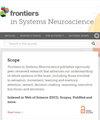Unifying biophysical consciousness theories with MaxCon: maximizing configurations of brain connectivity
IF 3.5
4区 医学
Q2 NEUROSCIENCES
引用次数: 0
Abstract
There is such a vast proliferation of scientific theories of consciousness that it is worrying some scholars. There are even competitions to test different theories, and the results are inconclusive. Consciousness research, far from converging toward a unifying framework, is becoming more discordant than ever, especially with respect to theoretical elements that do not have a clear neurobiological basis. Rather than dueling theories, an integration across theories is needed to facilitate a comprehensive view on consciousness and on how normal nervous system dynamics can develop into pathological states. In dealing with what is considered an extremely complex matter, we try to adopt a perspective from which the subject appears in relative simplicity. Grounded in experimental and theoretical observations, we advance an encompassing biophysical theory, MaxCon, which incorporates aspects of several of the main existing neuroscientific consciousness theories, finding convergence points in an attempt to simplify and to understand how cellular collective activity is organized to fulfill the dynamic requirements of the diverse theories our proposal comprises. Moreover, a computable index indicating consciousness level is presented. Derived from the level of description of the interactions among cell networks, our proposal highlights the association of consciousness with maximization of the number of configurations of neural network connections ―constrained by neuroanatomy, biophysics and the environment― that is common to all consciousness theories.用 MaxCon 统一生物物理意识理论:最大化大脑连接配置
关于意识的科学理论层出不穷,令一些学者感到担忧。甚至还出现了检验不同理论的竞赛,结果却没有定论。意识研究非但没有向统一的框架靠拢,反而变得比以往任何时候都更加不和谐,尤其是那些没有明确神经生物学基础的理论要素。我们需要的不是对立的理论,而是跨理论的整合,以促进对意识以及正常神经系统动态如何发展为病理状态的全面认识。在处理被认为是极其复杂的问题时,我们试图采用一种相对简单的视角。在实验和理论观察的基础上,我们提出了一个包罗万象的生物物理理论--MaxCon,它融合了现有的几种主要神经科学意识理论的各个方面,找到了交汇点,试图简化和理解细胞集体活动是如何组织起来以满足我们的建议所包含的各种理论的动态要求的。此外,我们还提出了一个表示意识水平的可计算指数。从细胞网络间相互作用的描述水平出发,我们的建议突出了意识与神经网络连接配置数量最大化的关联--它受到神经解剖学、生物物理学和环境的制约--这是所有意识理论的共同点。
本文章由计算机程序翻译,如有差异,请以英文原文为准。
求助全文
约1分钟内获得全文
求助全文
来源期刊

Frontiers in Systems Neuroscience
Neuroscience-Developmental Neuroscience
CiteScore
6.00
自引率
3.30%
发文量
144
审稿时长
14 weeks
期刊介绍:
Frontiers in Systems Neuroscience publishes rigorously peer-reviewed research that advances our understanding of whole systems of the brain, including those involved in sensation, movement, learning and memory, attention, reward, decision-making, reasoning, executive functions, and emotions.
 求助内容:
求助内容: 应助结果提醒方式:
应助结果提醒方式:


